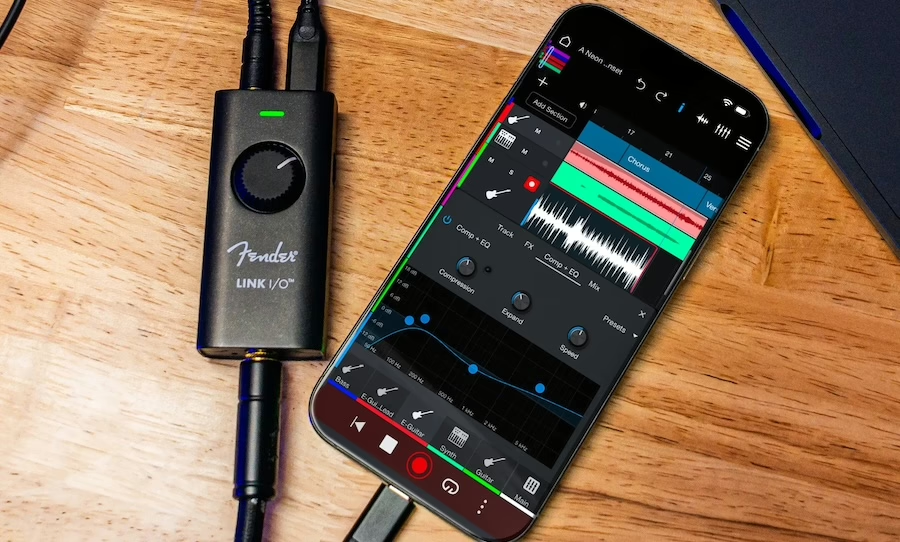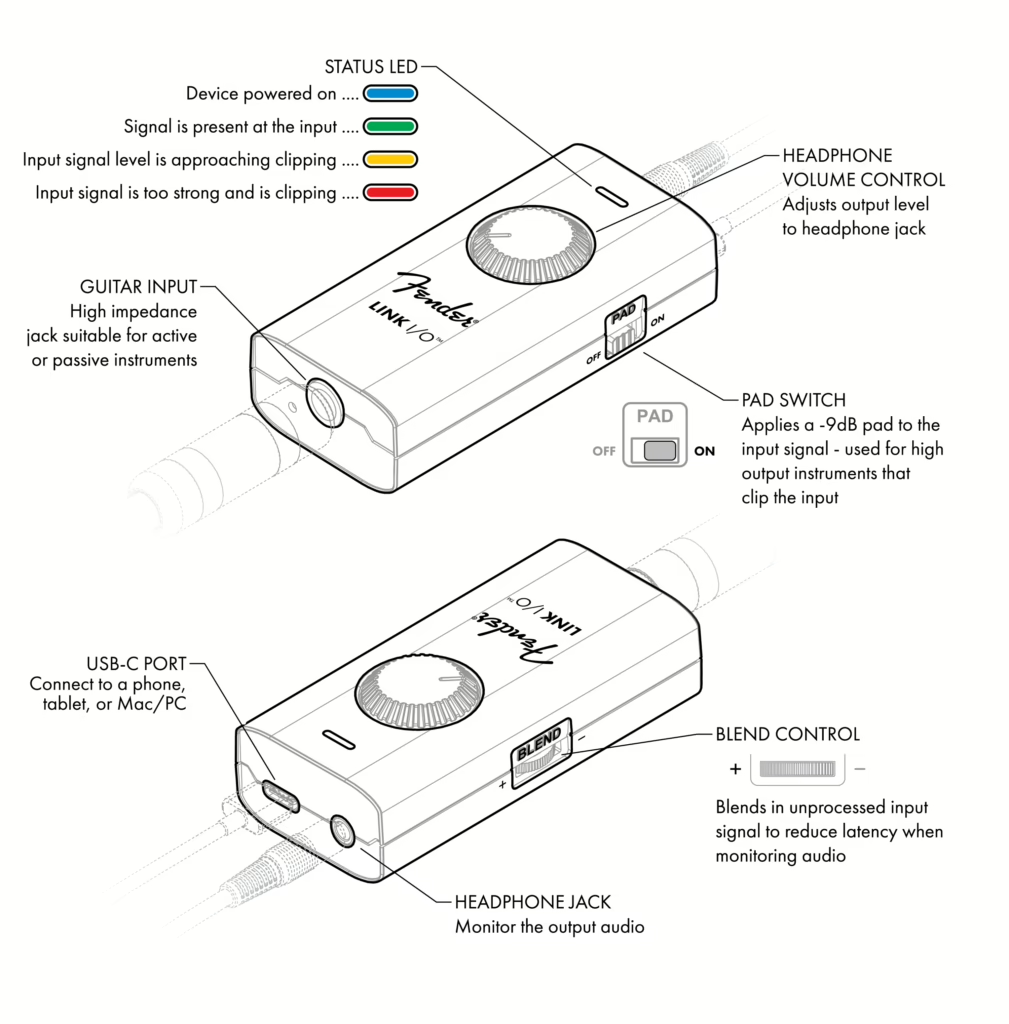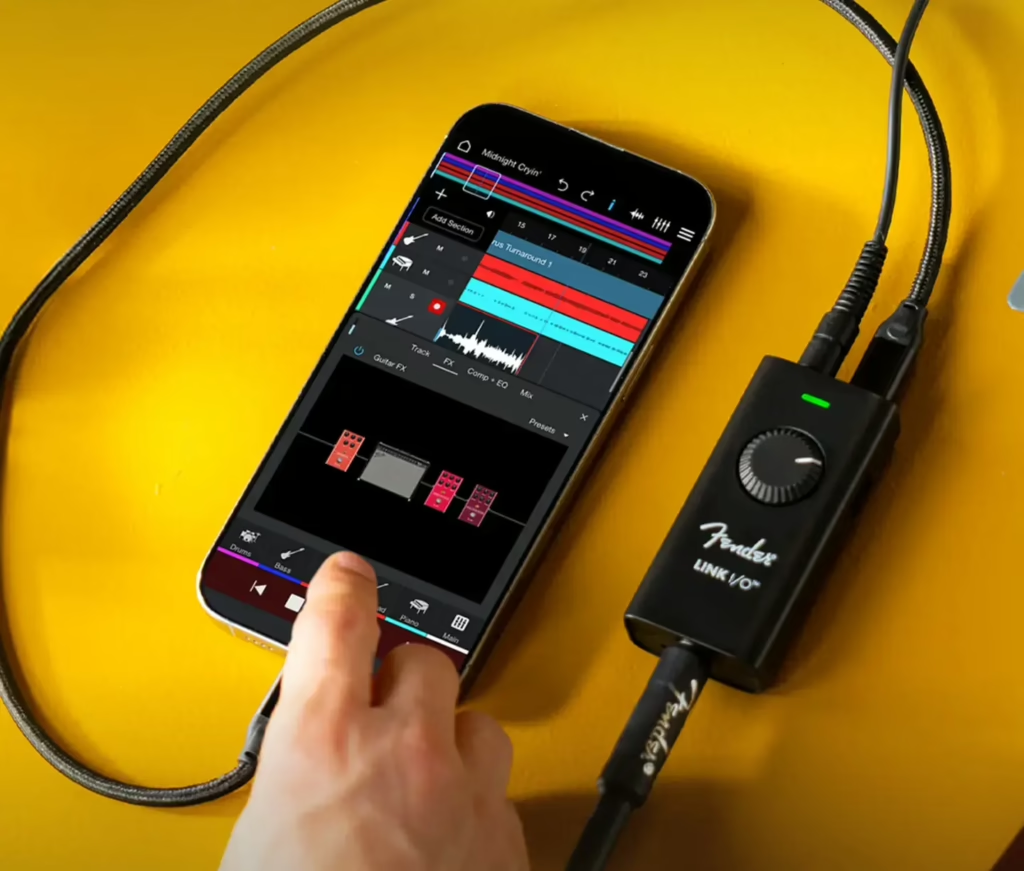REVIEW: Fender Link I/O and Fender Studio app
The world's premier guitar brand does tech the right way (and hints at big things on the horizon.)
by Paul French

Get mutech updates in your inbox
I’m sure I’m not alone in this, but something that I have always had a difficult time navigating in the recording space is the often clumsy language surrounding two very distinct workflows-that is the language of traditional Music Production versus that of Electronic Music Production.
For what appears to be two branches from the same tree, it’s actually wild to think of how little in common these two disciplines have historically shared, especially when we go into the language and technical considerations surrounding each.
Granted, in the early pioneering days of sequencing and MIDI functionality, Electronic Production would have had little, if any overlaps at all with the performance based, analogous band workflows that existed in the more ‘earthy’ genres that typified the 60’s and 70’s, but it has always felt like that little inclusion of that word ‘Electronic’ always brings with it a plethora of alternative workflows (and ways of thinking) often far removed from that of traditional music making. It’s these differing processes of composition and recording that have come to typify Electronic music (and in many ways alienated it from the guitar driven genres that came before.)
Combine this with the major differences in acoustic considerations between direct injection and the seemingly lost art of tracking instruments with microphones in the open air, and it is easy to understand just how different the two approaches have historically been, that is until recently.
With the audio interface and DAW serving as the proverbial watering hole where all sonic disciplines meet, and with guitars and synths becoming borderline interchangeable in the context of modern popular music, we are now seeing an abundance of cultural and technical overlap between these two diametrically opposed camps.
This is particularly evident with the biggest name in all things guitar, Fender, and their recent acquisition of home recording giant, Presonus.
It’s an exercise in getting to the watering hole first, and no doubt hints at a future focus on music technology for the iconic guitar brand, one that cements their ongoing commitment to accommodating the guitars new role in popular culture-as the provider of organic texture and vibe to be overlaid on top of the MIDI drumbeats or in-the-box workflows pioneered in the Electronic sector.

This brings us to Fender’s new Link I/O portable interface with accompanying Fender Studio app, the result of the brand’s acquired expertise in the home recording market (and the perfect affordable travel interface and small scale DAW solution for tracking audio on the fly.)
Providing latency free, album worthy 24-bit, 96kHz recording in a unit roughly the size of your average vape, the Link I/O serves as a small footprint, high quality offering and all at a remarkably affordable pricepoint (the kind of pricepoint that should make this a default stocking stuffer for both guitar and synth enthusiasts alike from here on out).
With a single 1/4-inch instrument input, a single 3.5mm headphone output and a USB-C port for connecting little matey to phones, tablets, Macs, and PCs- it’s a simple but practical affair, one that’s primarily focused on portability and getting line level instrumentation down on the move, be it guitar, bass, synth or other.
Think of it as a field recorder for instruments. That’s where the appeal of this product lies, in portability, workflow and flexibility in post.

Probably the main point of difference between the Link I/O and other pocket sized interfaces in this category (and where Fender get this one so right) is in the responsiveness and feel of the input for stringed instruments and how this works in conjunction with the various amp emulations and effects on offer in the brand’s proprietary, stripped back DAW, Fender Studio.
Suffice to say, Fender have pulled from their decades of R’n’D as one of the biggest names in amplification to ensure that the input on the Link I/O remains true to the real world Fender experience, in terms of recoil, feel and breakup. It’s actually quite remarkable how closely they have been able to replicate the precise IR and impedance of the classic Fender amp models. The 65’ Twin Reverb is a particular highlight and is sure to provide something quick and workable for even the most discerning of tone snobs.

What this means for us Synth and Sound Design nerds is that we also have plenty of distortion, saturation and drive options to experiment with, with the Link I/O and its accompanying software serving as a kind of modern, interface equivalent of the ‘distorted headphone amp’ sounds of yesteryear. This is a particularly fun way to add some additional harmonics and grit to your garden variety sonic palette (if things are getting stale) or provide a bit of separation when its required.
In terms of the accompanying software, Fender Studio provides an awesome (if minimalist) beginner DAW with a clean user interface and an exceptionally intuitive system of navigation. Anyone familiar with Presonus’ award-winning digital audio workstation, StudioOne Pro, will feel immediately at home, with borderline identical workflows on offer in terms of recording, editing and overall production (albeit in parred back form).
Along with some simple and sonically pleasant depictions of utilitarian effects like Compression, EQ, Reverb and Delay, we are also privy to some fun and quick fire vocal effects to play with like De-Tuner, Transformer, Ring Modulator and Vocoder-presumably for effecting imported vocal tracks or to be used in conjunction with a handheld dynamic and ¼ inch to XLR cable. These are an interesting inclusion and hint at the potential for even more stylistic versatility coming from Fender in regards to their music technology arm.
The ability to import audio and samples plus the ease of the editing functionality make this an awesome little setup for overdubbing audio tracks away from a traditional studio or more sophisticated home recording setup.
I tend not to be the kind of person who stresses a product’s dollar value in a review, but in the case of the Link I/O, the accessibility and affordability of the unit actively parlays into the workflow considerations and upside of the product. Chuck it in your luggage, keep one in your glove compartment, keep one at your parents house-that kind of thing.

For the lazy housecat in all of us, combining a Link I/O and any one of Fender’s Acoustasonic guitar range may be one of the best ‘couch to demo to gig’ songwriting workflows I have ever come across in any genre, requiring minimal effort and maximum continuity from the moment of inception to the stage.
All in all, the Fender Link I/O is an exceptional demoing tool, and the audio quality means that there are no issues keeping the DI’d signal for reamping and further editing down the line. The integration of the Fender Studio app also means that all this can be tracked to a click and grid for further exportation and workshopping in post, meaning plenty of flexibility in terms of where it fits in with your recording process.
In terms of workflow, it’s the perfect tool for pulling line level audio on the move or away from familiar surroundings and its clever input monitoring also make it an awesome tool for blocking out the world and blissing out, without having to worry about waking up the young family in the apartment next to you.
If you were looking for the absolute quickest and easiest method of getting an instrument into a phone or tablet (with the highest potential for future useability and manipulation), then this is it.
It’s a little room device with big room aspirations and in the world of recording workflows, that kind of thing often pays major dividends. I can only imagine that future iterations will include some kind of MIDI integration into the Link I/O and accompanying app, which will no doubt open up the functionality to even greater heights and truly span the divide between Rock band and Electronic producer once and for all.
To find out more about Fender Studio and Link I/O head to the Fender website, and check out our video review: